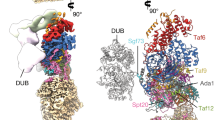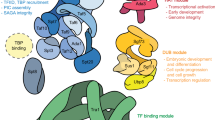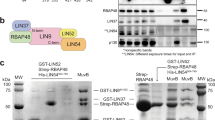Abstract
Eukaryotic transcriptional repressors function by recruiting large coregulatory complexes that target histone deacetylase enzymes to gene promoters and enhancers. Transcriptional repression complexes, assembled by the corepressor NCoR and its homolog SMRT, are crucial in many processes, including development and metabolic physiology. The core repression complex involves the recruitment of three proteins, HDAC3, GPS2 and TBL1, to a highly conserved repression domain within SMRT and NCoR. We have used structural and functional approaches to gain insight into the architecture and biological role of this complex. We report the crystal structure of the tetrameric oligomerization domain of TBL1, which interacts with both SMRT and GPS2, and the NMR structure of the interface complex between GPS2 and SMRT. These structures, together with computational docking, mutagenesis and functional assays, reveal the assembly mechanism and stoichiometry of the corepressor complex.
This is a preview of subscription content, access via your institution
Access options
Subscribe to this journal
Receive 12 print issues and online access
$189.00 per year
only $15.75 per issue
Buy this article
- Purchase on Springer Link
- Instant access to full article PDF
Prices may be subject to local taxes which are calculated during checkout







Similar content being viewed by others
References
Lazar, M.A. Nuclear receptor corepressors. Nucl. Recept. Signal. 1, e001 (2003).
Ahmad, K.F. et al. Mechanism of SMRT corepressor recruitment by the BCL6 BTB domain. Mol. Cell 12, 1551–1564 (2003).
Gelmetti, V. et al. Aberrant recruitment of the nuclear receptor corepressor-histone deacetylase complex by the acute myeloid leukemia fusion partner ETO. Mol. Cell. Biol. 18, 7185–7191 (1998).
Jayne, S., Zwartjes, C.G., van Schaik, F.M. & Timmers, H.T. Involvement of the SMRT/NCoR-HDAC3 complex in transcriptional repression by the CNOT2 subunit of the human Ccr4-Not complex. Biochem. J. 398, 461–467 (2006).
Kao, H.Y. et al. A histone deacetylase corepressor complex regulates the Notch signal transduction pathway. Genes Dev. 12, 2269–2277 (1998).
Wu, X., Li, H., Park, E.J. & Chen, J.D. SMRTE inhibits MEF2C transcriptional activation by targeting HDAC4 and 5 to nuclear domains. J. Biol. Chem. 276, 24177–24185 (2001).
Yoon, H.G., Chan, D.W., Reynolds, A.B., Qin, J. & Wong, J. N-CoR mediates DNA methylation-dependent repression through a methyl CpG binding protein Kaiso. Mol. Cell 12, 723–734 (2003).
Lutterbach, B. et al. ETO, a target of t(8;21) in acute leukemia, interacts with the N-CoR and mSin3 corepressors. Mol. Cell. Biol. 18, 7176–7184 (1998).
Jepsen, K. et al. Combinatorial roles of the nuclear receptor corepressor in transcription and development. Cell 102, 753–763 (2000).
Jepsen, K. et al. SMRT-mediated repression of an H3K27 demethylase in progression from neural stem cell to neuron. Nature 450, 415–419 (2007).
Barroso, I. et al. Dominant negative mutations in human PPARγ associated with severe insulin resistance, diabetes mellitus and hypertension. Nature 402, 880–883 (1999).
Cheng, G.X. et al. Distinct leukemia phenotypes in transgenic mice and different corepressor interactions generated by promyelocytic leukemia variant fusion genes PLZF-RARα and NPM-RARα. Proc. Natl. Acad. Sci. USA 96, 6318–6323 (1999).
Hong, S.H., David, G., Wong, C.W., Dejean, A. & Privalsky, M.L. SMRT corepressor interacts with PLZF and with the PML-retinoic acid receptor α (RARα) and PLZF-RARα oncoproteins associated with acute promyelocytic leukemia. Proc. Natl. Acad. Sci. USA 94, 9028–9033 (1997).
Melnick, A.M. et al. The ETO protein disrupted in t(8;21)-associated acute myeloid leukemia is a corepressor for the promyelocytic leukemia zinc finger protein. Mol. Cell. Biol. 20, 2075–2086 (2000).
Picard, F. et al. Sirt1 promotes fat mobilization in white adipocytes by repressing PPAR-γ. Nature 429, 771–776 (2004).
Guenther, M.G. et al. A core SMRT corepressor complex containing HDAC3 and TBL1, a WD40-repeat protein linked to deafness. Genes Dev. 14, 1048–1057 (2000).
Li, J. et al. Both corepressor proteins SMRT and N-CoR exist in large protein complexes containing HDAC3. EMBO J. 19, 4342–4350 (2000).
Wen, Y.D. et al. The histone deacetylase-3 complex contains nuclear receptor corepressors. Proc. Natl. Acad. Sci. USA 97, 7202–7207 (2000).
Heinzel, T. et al. A complex containing N-CoR, mSin3 and histone deacetylase mediates transcriptional repression. Nature 387, 43–48 (1997).
Nagy, L. et al. Nuclear receptor repression mediated by a complex containing SMRT, mSin3A, and histone deacetylase. Cell 89, 373–380 (1997).
Ishizuka, T. & Lazar, M.A. The nuclear receptor corepressor deacetylase activating domain is essential for repression by thyroid hormone receptor. Mol. Endocrinol. 19, 1443–1451 (2005).
Yin, L. et al. Rev-erbα, a heme sensor that coordinates metabolic and circadian pathways. Science 318, 1786–1789 (2007).
Guenther, M.G., Barak, O. & Lazar, M.A. The SMRT and N-CoR corepressors are activating cofactors for histone deacetylase 3. Mol. Cell. Biol. 21, 6091–6101 (2001).
Yoon, H.G. et al. Purification and functional characterization of the human N-CoR complex: the roles of HDAC3, TBL1 and TBLR1. EMBO J. 22, 1336–1346 (2003).
Zhang, J., Kalkum, M., Chait, B.T. & Roeder, R.G. The N-CoR-HDAC3 nuclear receptor corepressor complex inhibits the JNK pathway through the integral subunit GPS2. Mol. Cell 9, 611–623 (2002).
Hörlein, A.J. et al. Ligand-independent repression by the thyroid hormone receptor mediated by a nuclear receptor co-repressor. Nature 377, 397–404 (1995).
Peng, Y.C., Breiding, D.E., Sverdrup, F., Richard, J. & Androphy, E.J. AMF-1/Gps2 binds p300 and enhances its interaction with papillomavirus E2 proteins. J. Virol. 74, 5872–5879 (2000).
Peng, Y.C. et al. AMF1 (GPS2) modulates p53 transactivation. Mol. Cell. Biol. 21, 5913–5924 (2001).
Jakobsson, T. et al. GPS2 is required for cholesterol efflux by triggering histone demethylation, LXR recruitment, and coregulator assembly at the ABCG1 locus. Mol. Cell 34, 510–518 (2009).
Zhang, D., Harry, G.J., Blackshear, P.J. & Zeldin, D.C. G-protein pathway suppressor 2 (GPS2) interacts with the regulatory factor X4 variant 3 (RFX4_v3) and functions as a transcriptional co-activator. J. Biol. Chem. 283, 8580–8590 (2008).
Degenhardt, Y.Y. & Silverstein, S.J. Gps2, a protein partner for human papillomavirus E6 proteins. J. Virol. 75, 151–160 (2001).
Lee, T.H., Yi, W., Griswold, M.D., Zhu, F. & Her, C. Formation of hMSH4-hMSH5 heterocomplex is a prerequisite for subsequent GPS2 recruitment. DNA Repair (Amst.) 5, 32–42 (2006).
Yan, H.T. et al. Molecular analysis of TBL1Y, a Y-linked homologue of TBL1X related with X-linked late-onset sensorineural deafness. J. Hum. Genet. 50, 175–181 (2005).
Perissi, V., Aggarwal, A., Glass, C.K., Rose, D.W. & Rosenfeld, M.G. A corepressor/coactivator exchange complex required for transcriptional activation by nuclear receptors and other regulated transcription factors. Cell 116, 511–526 (2004).
Hartman, H.B., Yu, J., Alenghat, T., Ishizuka, T. & Lazar, M.A. The histone-binding code of nuclear receptor co-repressors matches the substrate specificity of histone deacetylase 3. EMBO Rep. 6, 445–451 (2005).
Choi, H.K. et al. Function of multiple Lis-Homology domain/WD-40 repeat-containing proteins in feed-forward transcriptional repression by silencing mediator for retinoic and thyroid receptor/nuclear receptor corepressor complexes. Mol. Endocrinol. 22, 1093–1104 (2008).
Oakley, M.G. & Hollenbeck, J.J. The design of antiparallel coiled coils. Curr. Opin. Struct. Biol. 11, 450–457 (2001).
Kim, M.H. et al. The structure of the N-terminal domain of the product of the lissencephaly gene Lis1 and its functional implications. Structure 12, 987–998 (2004).
Mikolajka, A. et al. Structure of the N-terminal domain of the FOP (FGFR1OP) protein and implications for its dimerization and centrosomal localization. J. Mol. Biol. 359, 863–875 (2006).
Dominguez, C., Boelens, R. & Bonvin, A.M. HADDOCK: a protein-protein docking approach based on biochemical or biophysical information. J. Am. Chem. Soc. 125, 1731–1737 (2003).
Codina, A. et al. Structural insights into the interaction and activation of histone deacetylase 3 by nuclear receptor corepressors. Proc. Natl. Acad. Sci. USA 102, 6009–6014 (2005).
Li, J., Lin, Q., Wang, W., Wade, P. & Wong, J. Specific targeting and constitutive association of histone deacetylase complexes during transcriptional repression. Genes Dev. 16, 687–692 (2002).
Li, J. & Wang, C.Y. TBL1-TBLR1 and beta-catenin recruit each other to Wnt target-gene promoter for transcription activation and oncogenesis. Nat. Cell Biol. 10, 160–169 (2008).
Cerna, D. & Wilson, D.K. The structure of Sif2p, a WD repeat protein functioning in the SET3 corepressor complex. J. Mol. Biol. 351, 923–935 (2005).
Chen, G. & Courey, A.J. Groucho/TLE family proteins and transcriptional repression. Gene 249, 1–16 (2000).
Varanasi, U.S., Klis, M., Mikesell, P.B. & Trumbly, R.J. The Cyc8 (Ssn6)-Tup1 corepressor complex is composed of one Cyc8 and four Tup1 subunits. Mol. Cell. Biol. 16, 6707–6714 (1996).
Gerlitz, G., Darhin, E., Giorgio, G., Franco, B. & Reiner, O. Novel functional features of the Lis-H domain: role in protein dimerization, half-life and cellular localization. Cell Cycle 4, 1632–1640 (2005).
Ghisletti, S. et al. Cooperative NCoR/SMRT interactions establish a corepressor-based strategy for integration of inflammatory and anti-inflammatory signaling pathways. Genes Dev. 23, 681–693 (2009).
Hong, W. et al. Bag-1M inhibits the transactivation of the glucocorticoid receptor via recruitment of corepressors. FEBS Lett. 583, 2451–2456 (2009).
Tomita, A., Buchholz, D.R. & Shi, Y.B. Recruitment of N-CoR/SMRT-TBLR1 corepressor complex by unliganded thyroid hormone receptor for gene repression during frog development. Mol. Cell. Biol. 24, 3337–3346 (2004).
Varlakhanova, N., Hahm, J.B. & Privalsky, M.L. Regulation of SMRT corepressor dimerization and composition by MAP kinase phosphorylation. Mol. Cell. Endocrinol. published online, doi:10.1016/j.mce.2010.10.010 (19 October 2010).
Couture, J.F., Collazo, E. & Trievel, R.C. Molecular recognition of histone H3 by the WD40 protein WDR5. Nat. Struct. Mol. Biol. 13, 698–703 (2006).
Song, J.J., Garlick, J.D. & Kingston, R.E. Structural basis of histone H4 recognition by p55. Genes Dev. 22, 1313–1318 (2008).
Wang, Z. et al. Genome-wide mapping of HATs and HDACs reveals distinct functions in active and inactive genes. Cell 138, 1019–1031 (2009).
Leslie, A.G. The integration of macromolecular diffraction data. Acta Crystallogr. D 62, 48–57 (2006).
Collaborative Computational Project, Number 4. The CCP4 suite: programs for protein crystallography. Acta Crystallogr. D 50, 760–763 (1994).
McCoy, A.J. et al. Phaser crystallographic software. J. Appl. Crystallogr. 40, 658–674 (2007).
Brunger, A.T. Version 1.2 of the Crystallography and NMR system. Nat. Protoc. 2, 2728–2733 (2007).
Emsley, P. & Cowtan, K. Coot: model-building tools for molecular graphics. Acta Crystallogr. D 60, 2126–2132 (2004).
Murshudov, G.N., Vagin, A.A. & Dodson, E.J. Refinement of macromolecular structures by the maximum-likelihood method. Acta Crystallogr. D 53, 240–255 (1997).
Acknowledgements
We thank P. Moody, P. Elliot and the beamline staff at DIAMOND and the European Synchrotron Radiation Facility for help with data collection. This work was supported by the Wellcome Trust (085408) and the UK Medical Research Council.
Author information
Authors and Affiliations
Contributions
The contributions of J.O., L.F. and P.J.W. were crucial to the final manuscript and these authors should be considered co–first authors. J.O. (assisted by J.T.G.) performed most of the protein cloning, expression, purification and interaction mapping, although important preliminary experiments were performed by B.C.K. J.O. prepared the GPS2–SMRT complex for NMR structure determination, which was carried out by J.-C.Y. and D.N. Crystallizations were performed primarily by J.O., with some later trials by J.A.G. and L.F. Crystal structures were determined by L.F., J.O. and J.W.R.S. The interaction motifs in GPS2 and SMRT were identified by J.W.R.S. and tested in pull-down experiments by J.O. Fluorescence polarization, coimmunoprecipitation and cotransfection-purification assays were performed by P.J.W. The two-hybrid assays, gel filtrations and NMR comparisons of wild-type and mutant TBL1 were performed by P.J.W., Z.C. and B.T.G. In silico docking experiments were performed by T.K. The laboratories of L.N. and D.N. provided experimental expertise for transfection and NMR studies, respectively. J.W.R.S. planned and supervised the project and prepared the manuscript with assistance from the other authors.
Corresponding author
Ethics declarations
Competing interests
The authors declare no competing financial interests.
Supplementary information
Supplementary Text and Figures
Supplementary Figs. 1–3 and Supplementary Methods (PDF 3716 kb)
Rights and permissions
About this article
Cite this article
Oberoi, J., Fairall, L., Watson, P. et al. Structural basis for the assembly of the SMRT/NCoR core transcriptional repression machinery. Nat Struct Mol Biol 18, 177–184 (2011). https://doi.org/10.1038/nsmb.1983
Received:
Accepted:
Published:
Issue Date:
DOI: https://doi.org/10.1038/nsmb.1983
This article is cited by
-
Nuclear receptor co-repressor NCOR2 and its relation to GPER with prognostic impact in ovarian cancer
Journal of Cancer Research and Clinical Oncology (2023)
-
The MiDAC histone deacetylase complex is essential for embryonic development and has a unique multivalent structure
Nature Communications (2020)
-
Targeting nuclear β-catenin as therapy for post-myeloproliferative neoplasm secondary AML
Leukemia (2019)
-
Hepatocyte-specific loss of GPS2 in mice reduces non-alcoholic steatohepatitis via activation of PPARα
Nature Communications (2019)
-
1H, 13C and 15N chemical shift assignment of lissencephaly-1 homology (LisH) domain homodimer of human two-hybrid-associated protein 1 with RanBPM (Twa1)
Biomolecular NMR Assignments (2018)



